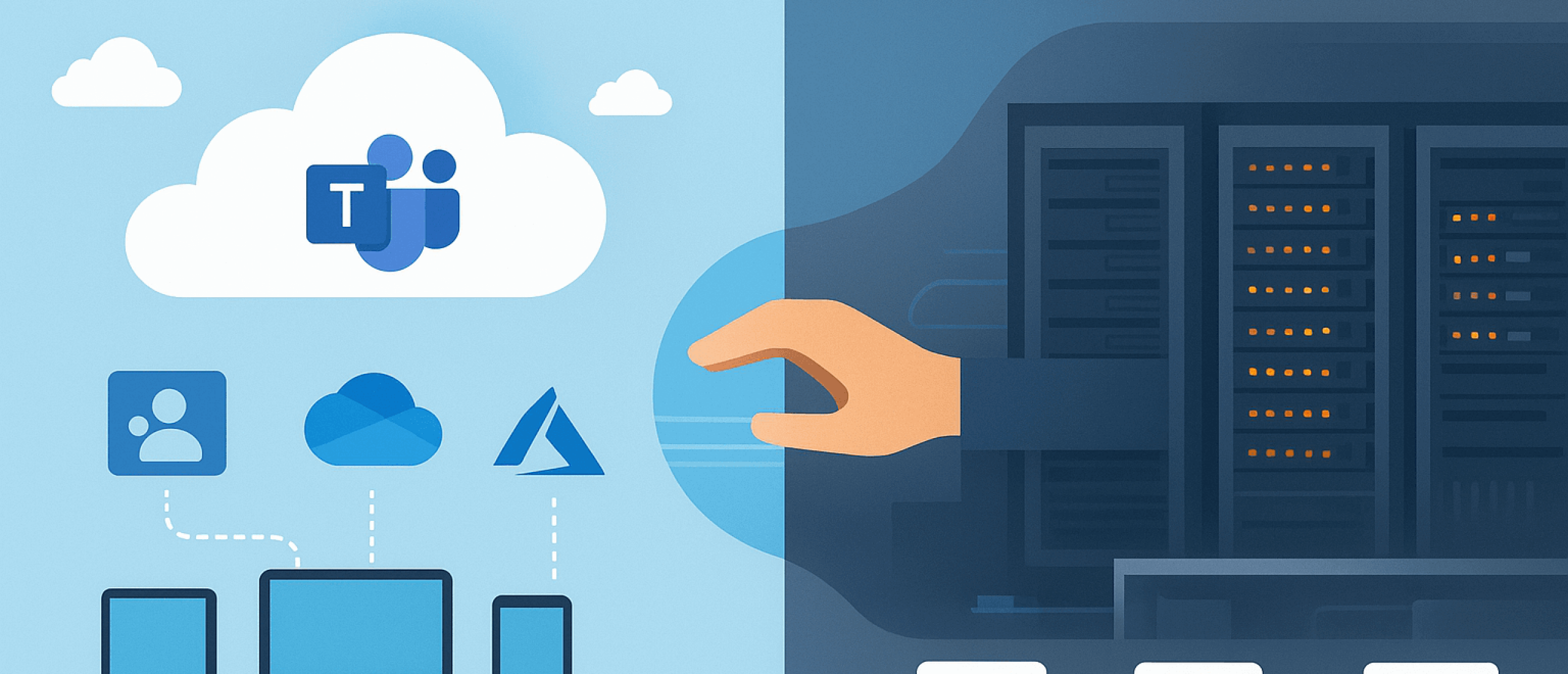
In today’s digital world, many organizations choose a hybrid IT environment. This strategy combines the benefits of cloud solutions with the control and security of on-premises software. This way, you gain flexibility for less critical processes while maintaining ownership of business-critical data and systems.
Softtrader supports companies in this hybrid model by providing affordable, legal, and perpetual Microsoft licenses for the on-premises part. This allows you to control costs and retain full control over your infrastructure. In this blog, you will learn more about hybrid IT environments and how you can save on on-premises software.
What is a hybrid IT environment?
A hybrid IT environment is a combination of two types of IT solutions that complement each other: cloud solutions and on-premises software.
Cloud solutions are ideal for scalable and flexible applications. These include collaboration tools, data analytics, or backup services that you prefer not to manage yourself. They offer dynamic capacity, rapid deployment, and easy maintenance, allowing your organization to grow without large investments in hardware or staff.
On the other hand, on-premises software is suitable for business-critical systems and sensitive data that you prefer to keep entirely under your own management. This gives you direct control over performance, security, and compliance, making it easier to meet legal and regulatory requirements regarding data protection. We offer on-premises software licenses in our portfolio. Our pre-owned Microsoft licenses allow you to save significantly on your Microsoft on-premises software.
Advantages of a hybrid IT strategy
A hybrid IT strategy offers organizations many advantages through a smart combination of on-premises software and cloud solutions. First, you gain full control over business-critical data and processes. Systems essential to your organization’s continuity remain under your direct management, ensuring maximum security, reliability, and compliance. For example, a healthcare organization can store sensitive data locally using on-premises software, preventing it from being exposed online. At the same time, they can use Microsoft Teams as a cloud solution for communication.
You also benefit from the scalability of cloud solutions for less critical applications, such as collaboration tools, marketing software, or data analytics platforms that grow with your organization without requiring additional hardware or staff investments.
Additionally, a hybrid approach provides cost efficiency. You can invest more strategically in business-critical systems, keeping some on-premises while using the cloud for others. This prevents unnecessary expenses on costly cloud subscriptions for software you don’t need continuously.
Another advantage is improved business continuity. If there’s a disruption in the cloud, your core systems under your own management remain operational. This minimizes risks and ensures your organization runs smoothly regardless of external factors. Cloud outages do happen occasionally, and you can read more about this in our blog on Microsoft downtime.
By strategically deciding which systems run in the cloud and which stay on-premises, your organization maintains control over both performance and costs while remaining flexible to adapt to changes in capacity, usage, or business needs.
Using On-Premises Software Within Hybrid IT Environments
In a hybrid IT environment, it may be wise to run certain systems and applications on-premises while placing other processes in the cloud. This gives you the best of both worlds. Business-critical software remains under your control, while less critical applications run in the cloud for scalability and flexibility.
On-premises systems also guarantee stability and predictable performance where you need them most, while cloud solutions scale dynamically alongside your organization.
A hybrid approach also helps you meet compliance requirements and keep sensitive data stored locally, while still benefiting from the security and redundancy of cloud services. By finding the right balance between cloud and on-premises, you can respond quickly to changes in usage, capacity, or business needs. On-premises software in a hybrid environment is not a standalone element but a complementary part of a flexible, secure, and cost-efficient IT infrastructure.
Saving with Softtrader Licenses
Softtrader provides pre-owned Microsoft licenses that are legal and perpetual. This offers several benefits:
One-time purchase cost: You buy the license once and retain full ownership.
No ongoing subscription fees: No surprise price increases or variable monthly costs.
Significant cost savings: Up to 70% cheaper than new licenses.
Full compliance: Licenses fully comply with European regulations.
For on-premises applications such as Windows Server, SQL Server, and Microsoft Office, Softtrader offers a reliable and cost-effective solution. With Softtrader’s licenses, you retain control over the on-premises part of your hybrid IT environment without compromising on security, performance, or stability.
For example, an SME can save significantly on expensive Microsoft licenses. As an alternative to Microsoft 365, you can choose Microsoft Office packages with the same apps and functionalities. At Softtrader, you can purchase these packages pre-owned, allowing you to save money and avoid being tied to a subscription.
Successfully Implementing Hybrid IT with Softtrader
A hybrid IT environment combines the best of cloud and on-premises software. By keeping business-critical systems under your own management and placing other processes in the cloud, you achieve a strong balance between flexibility, security, and cost control.
With Softtrader’s support through affordable, legal, and perpetual Microsoft licenses, your on-premises software remains reliable, compliant, and fully under your control. This makes your hybrid IT environment sustainable, predictable, and future-proof. If you are interested in our offering, request a free quote or contact our team. We are ready to help your company save on your on-premises software.












